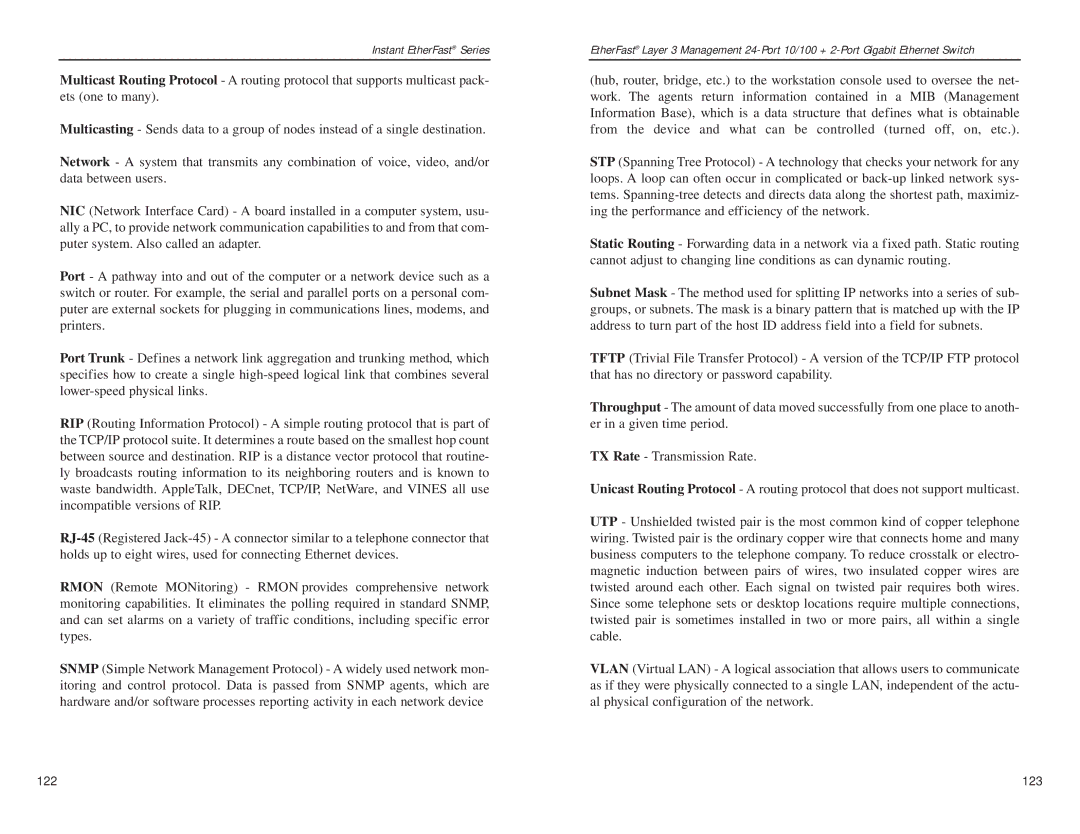Instant EtherFast® Series
Multicast Routing Protocol - A routing protocol that supports multicast pack- ets (one to many).
Multicasting - Sends data to a group of nodes instead of a single destination.
Network - A system that transmits any combination of voice, video, and/or data between users.
NIC (Network Interface Card) - A board installed in a computer system, usu- ally a PC, to provide network communication capabilities to and from that com- puter system. Also called an adapter.
Port - A pathway into and out of the computer or a network device such as a switch or router. For example, the serial and parallel ports on a personal com- puter are external sockets for plugging in communications lines, modems, and printers.
Port Trunk - Defines a network link aggregation and trunking method, which specifies how to create a single
RIP (Routing Information Protocol) - A simple routing protocol that is part of the TCP/IP protocol suite. It determines a route based on the smallest hop count between source and destination. RIP is a distance vector protocol that routine- ly broadcasts routing information to its neighboring routers and is known to waste bandwidth. AppleTalk, DECnet, TCP/IP, NetWare, and VINES all use incompatible versions of RIP.
RMON (Remote MONitoring) - RMON provides comprehensive network monitoring capabilities. It eliminates the polling required in standard SNMP, and can set alarms on a variety of traffic conditions, including specific error types.
SNMP (Simple Network Management Protocol) - A widely used network mon- itoring and control protocol. Data is passed from SNMP agents, which are hardware and/or software processes reporting activity in each network device
EtherFast® Layer 3 Management
(hub, router, bridge, etc.) to the workstation console used to oversee the net- work. The agents return information contained in a MIB (Management Information Base), which is a data structure that defines what is obtainable from the device and what can be controlled (turned off, on, etc.).
STP (Spanning Tree Protocol) - A technology that checks your network for any loops. A loop can often occur in complicated or
Static Routing - Forwarding data in a network via a fixed path. Static routing cannot adjust to changing line conditions as can dynamic routing.
Subnet Mask - The method used for splitting IP networks into a series of sub- groups, or subnets. The mask is a binary pattern that is matched up with the IP address to turn part of the host ID address field into a field for subnets.
TFTP (Trivial File Transfer Protocol) - A version of the TCP/IP FTP protocol that has no directory or password capability.
Throughput - The amount of data moved successfully from one place to anoth- er in a given time period.
TX Rate - Transmission Rate.
Unicast Routing Protocol - A routing protocol that does not support multicast.
UTP - Unshielded twisted pair is the most common kind of copper telephone wiring. Twisted pair is the ordinary copper wire that connects home and many business computers to the telephone company. To reduce crosstalk or electro- magnetic induction between pairs of wires, two insulated copper wires are twisted around each other. Each signal on twisted pair requires both wires. Since some telephone sets or desktop locations require multiple connections, twisted pair is sometimes installed in two or more pairs, all within a single cable.
VLAN (Virtual LAN) - A logical association that allows users to communicate as if they were physically connected to a single LAN, independent of the actu- al physical configuration of the network.
122 | 123 |
